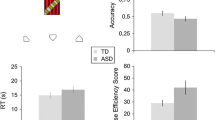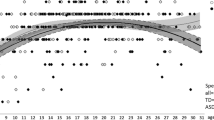Abstract
The aim of this investigation was to explore the degree to which specific subsets of autistic-like traits relate to performance on the Embedded Figures Test (Witkin et al. in A manual for the embedded figures test. Consulting Psychologists Press, Palo Alto, CA, 1971). In the first group-based investigation with this focus, students were selected for their extreme scores (either high or low) on each of the ‘Social Skills’ and ‘Details/Patterns’ factors of the Autism Spectrum Quotient (Baron-Cohen et al. in J Austim Dev Disord 31:5–17, 2001). The resulting 2 × 2 factorial design permitted examination of the degree to which the social and non-social autistic-like traits separately relate to EFT performance. Surprisingly, in two studies, superior EFT performance was found to relate only to greater social difficulty, suggesting that the local processing bias in autism may be linked specifically to the social deficits.
Similar content being viewed by others
References
Almeida, R., Dickinson, J., Maybery, M., Badcock, J., & Badcock, D. (2010a). A new step toward understanding embedded figures test performance in the autism spectrum: The radial frequency search task. Neuropsychologia, 48(2), 374–381.
Almeida, R., Dickinson, J., Maybery, M., Badcock, J., & Badcock, D. (2010b). Visual search performance in the autism spectrum II: The radial frequency search task with additional segmentation cues. Neuropsychologia, 48(14), 4117–4124.
American Psychiatric Association. (2000). Diagnostic and statistical manual of mental disorders: DSM IV. Washington, DC: American Psychiatric Publishing.
Austin, E. (2005). Personality correlates of the broader autism phenotype as assessed by the Autism Spectrum Quotient (AQ). Personality and Individual Differences, 38, 174–183.
Baron-Cohen, S., & Belmonte, M. (2005). Autism: A window onto the development of the social and the analytic brain. Annual Review of Neuroscience, 28, 109–126.
Baron-Cohen, S., & Hammer, J. (1997). Parents of children with Asperger syndrome: What is the cognitive phenotype? Journal of Cognitive Neuroscience, 9, 548–554.
Baron-Cohen, S., Jolliffe, T., Mortimore, C., & Robertson, M. (1997). Another advanced test of theory of mind: Evidence from very high functioning adults with autism or Asperger syndrome. Journal of Child Psychology and Psychiatry, 38, 813–822.
Baron-Cohen, S., Wheelwright, S., Burtenshaw, A., & Hobson, E. (2007). Mathematical talent is linked to autism. Human Nature, 18, 125–131.
Baron-Cohen, S., Wheelwright, S., Lawson, J., Griffin, R., & Hill, J. (2002). The exact mind: Empathising and systemising in autism spectrum conditions. In U. Goswami (Ed.), Handbook of childhood cognitive development (pp. 491–508). Oxford: Blackwell.
Baron-Cohen, S., Wheelwright, S., Skinner, R., Martin, J., & Clubley, E. (2001). The autism-spectrum quotient (AQ): Evidence from asperger syndrome/high-functioning autism, males and females, scientists and mathematicians. Journal of Autism and Developmental Disorders, 31, 5–17.
Behrmann, M., Thomas, C., & Humphries, K. (2006). Seeing it differently: Visual processing in autism. Trends in Cognitive Sciences, 10(6), 258–264.
Best, C., Moffat, V., Power, M., Owens, D., & Johnstone, E. (2008). The boundaries of the cognitive phenotype of autism: Theory of mind, central coherence and ambiguous figure perception in young people with autistic traits. Journal of Autism and Developmental Disorders, 38, 840–847.
Bishop, D., Maybery, M., Maley, A., Wong, S., Hill, W., & Hallmayer, J. (2004). Using self-report to identify the broad phenotype in parents of children with autistic spectrum disorders: A study using the Autism Spectrum Quotient. Journal of Child Psychology and Psychiatry, 45, 1431–1436.
Bolte, S., Holtmann, M., Poustka, F., Scheurich, A., & Schmidt, L. (2007). Gestalt perception and local-global processing in highfunctioning autism. Journal of Autism and Developmental Disorders, 37(8), 1493–1504.
Bolte, S., & Poustka, F. (2006). The broader cognitive phenotype of autism in parents: How specific is the tendency for local processing and executive function. Journal of Child Psychology and Psychiatry, 47, 639–645.
Burnette, C., Mundy, P., Meyer, J., Sutton, S., Vaughan, A., & Charak, D. (2005). Weak central coherence and its relations to theory of mind and anxiety in autism. Journal of Autism and Developmental Disorders, 35, 63–73.
Cattell, R. (1973). Manual for the Cattell culture fair intelligence test. Champaign, IL: Institute for Personality and Ability Testing.
Chasson, G., Timpano, K., Greenberg, J., Shaw, A., Singer, T., & Wilhelm, S. (2011). Shared social competence impairment: Another link between the obsessive-compulsive and autism spectrums? Clinical Psychology Review, 31(5), 653–662.
Chen, Y.-H., Rodgers, J., & McConachie, H. (2009). Restricted and repetitive behaviours, sensory processing and cognitive style in children with ASDs. Journal of Autism and Developmental Disorders, 39(4), 635–642.
Constantino, J., & Todd, R. (2005). Intergenerational transmission of subthreshold autistic traits in the general population. Biological Psychiatry, 57, 655–660.
Drake, J., Redash, A., Coleman, K., Haimson, J., & Winner, E. (2010). ‘Autistic’ local processing bias also found in children gifted in realistic drawing. Journal of Autism and Developmental Disorders, 40(6), 762–773.
Dworzynski, K., Happé, F., Bolton, P., & Ronald, A. (2009). Relationship between symptom domains in autism spectrum disorders: A population based twin study. Journal of Autism and Developmental Disorders, 39, 1197–1210.
Evans, D., Elliot, J., & Packard, M. (2001). Visual organization and perceptual closure are related to compulsive-like behaviour in typically developing children. Merrill-Palmer Quarterly, 47(3), 323–335.
Fairburn, C., Cooper, Z., & Shafran, R. (2003). Cognitive behaviour therapy for eating disorders: A “transdiagnostic” theory and treatment. Behaviour Research and Therapy, 41(5), 509–528.
Frith, U. (1989). Autism: Explaining the enigma. Oxford: Blackwell.
Frith, U., & Happé, F. (1994). Autism: Beyond “theory of mind”. Cognition, 50, 115–132.
Fugard, A., Stewart, M., & Stenning, K. (2011). Visual/verbal-analytic reasoning bias as a function of self-reported autistic-like traits: A study of typically developing individuals solving Raven's Advanced Progressive Matrices. Autism, 15(3), 327–340.
Grinter, E., Maybery, M., & Badcock, D. (2010). Vision in developmental disorders: Is there a dorsal stream deficit? Brain Research Bulletin, 82, 147–160.
Grinter, E., Maybery, M., Van Beek, P., Pellicano, E., Badcock, J., & Badcock, D. (2009a). Global visual processing and self-rated autistic-like traits. Journal of Autism and Developmental Disorders, 39, 1278–1290.
Grinter, E., Van Beek, P., Maybery, M., & Badcock, D. (2009b). Brief report: Visuospatial analysis and self-rated autistic-like traits. Journal of Autism and Developmental Disorders, 39, 670–677.
Happé, F. (1997). Central coherence and theory of mind in autism: Reading homographs in context. British Journal of Developmental Psychology, 15, 1–12.
Happé, F., Briskman, J., & Frith, U. (2001). Exploring the cognitive phenotype of autism: Weak “central coherence” in parents and siblings of children with autism: I. Experimental tests. Journal of Child Psychology and Psychiatry, 42, 299–307.
Happé, F., & Frith, U. (1996). The neuropsychology of autism. Brain, 119, 1377–1400.
Happé, F., & Frith, U. (2006). The weak central coherence account: Detail-focused cognitive style in autism spectrum disorders. Journal of Autism and Developmental Disorders, 36, 5–25.
Hoekstra, R., Bartels, M., Cath, D., & Boomsma, D. (2008). Factor structure, reliability and criterion validity of the autism-spectrum quotient (AQ): A study in Dutch population and patient groups. Journal of Autism and Developmental Disorders, 38(8), 1555–1566.
Hurst, R., Mitchell, J., Kimbrel, N., Kwapil, T., & Nelson-Gray, R. (2007a). Examination of the reliability and factor structure of the Autism Spectrum Quotient (AQ) in a non-clinical sample. Personality and Individual Differences, 43, 1938–1948.
Hurst, R., Nelson-Gray, R., Mitchell, J., & Kwapil, T. (2007b). The relationship of Asperger’s characteristics and schizotypal personality traits in a non-clinical adult sample. Journal of Autism and Developmental Disorders, 37, 1711–1720.
Jarrold, C., Butler, D., Cottington, W., & Jimenez, F. (2000). Linking theory of mind and central coherence in autism and in the general population. Developmental Psychology, 36, 126–138.
Jolliffe, T., & Baron-Cohen, S. (1997). Are people with autism and Asperger syndrome faster than normal on the embedded figures test? Journal of Child Psychology and Psychiatry, 38, 527–534.
Jolliffe, T., & Baron-Cohen, S. (1999). A test of central coherence theory: Linguistic processing in high-functioning adults with autism or Asperger syndrome: Is local coherence impaired? Cognition, 71, 149–185.
Landgraf, S., Amado, I., Purkhart, R., Ries, J., Olié, J.-P., & van der Meer, E. (2011). Visuo-spatial cognition in schizophrenia: Confirmation of a preference for local information processing. Schizophrenia Research, 127(1–3), 163–170.
Lord, C., Rutter, M., & Le Couteur, A. (1994). Autism diagnostic interview—revised. Journal of Autism and Developmental Disorders, 24, 659–685.
Mason, O., Linney, Y., & Claridge, G. (2005). Short scales for measuring schizotypy. Schizophrenia Research, 78, 293–296.
Morgan, B., Maybery, M., & Durkin, K. (2003). Weak central coherence, poor joint attention, and low verbal IQ: Independent deficits in early autism. Developmental Psychology, 39, 646–656.
Pellicano, E., Maybery, M., & Durkin, K. (2005). Central coherence in typically developing preschoolers: Does it cohere and is it related to mindreading and executive control? Journal of Child Psychology and Psychiatry, 46, 533–547.
Pellicano, E., Maybery, M., Durkin, K., & Maley, A. (2006). Multiple cognitive capabilities/deficits in children with an autism spectrum disorder: “Weak” central coherence and its relationship to theory of mind and executive control. Development and Psychopathology, 18, 77–98.
Penn, D., Ritchie, M., Francis, J., Combs, D., & Martin, J. (2002). Social perception in schizophrenia: The role of context. Psychiatry Research, 109(2), 149–159.
Russell-Smith, S., Maybery, M., & Bayliss, D. (2010). Are the autism and positive schizotypy spectra diametrically opposed in local versus global processing? Journal of Autism and Developmental Disorders, 40(8), 968–977.
Russell-Smith, S., Maybery, M., & Bayliss, D. (2011). Relationships between autistic-like and schizotypy traits: An analysis using the Autism Spectrum Quotient and Oxford-Liverpool inventory of feelings and experiences. Personality and Individual Differences, 51(2), 128–132.
Skuse, D., Mandy, W., Steer, C., Miller, L., Goodman, R., Lawrence, K., et al. (2009). Social communication competence and functional adaptation in a general population of children: Preliminary evidence of sex-by-verbal IQ difference risk. Journal of the American Academy of Child and Adolescent Psychiatry, 48(2), 128–137.
South, M., Ozonoff, S., & McMahon, W. (2007). The relationship between executive functioning, central coherence, and repetitive behaviors in the high-functioning autism spectrum. Autism, 11, 437–451.
Speer, L., Cook, A., McMahon, W., & Clark, E. (2007). Face processing in children with autism: Effects of stimulus contents and type. Autism, 11(3), 265–277.
Spek, A., Scholte, E., & Berckelaer-Onnes, I. (2011). Local information processing in adults with high functioning autism and Asperger syndrome: The usefulness of neuropsychological tests and self-reports. Journal of Autism and Developmental Disorders, 41(7), 859–869.
Stewart, M., & Austin, E. (2009). The structure of the autism-spectrum quotient (AQ): Evidence from a student sample in Scotland. Personality and Individual Differences, 47, 224–228.
Tsakanikos, E., & Reed, P. (2003). Visuo-spatial processing and dimensions of schizotypy: Figure-ground segregation as a function of psychotic-like features. Personality and Individual Differences, 35, 703–712.
Walter, E., Dassonville, P., & Bochsler, T. (2009). A specific trait that modulates visuospatial illusion susceptibility. Journal of Autism and Developmental Disorders, 39(2), 339–349.
Wechsler, D. (1999). Wechsler abbreviated scale of intelligence (WASI). San Antonio, TX: Harcourt Assessment.
Whitney, J., Easter, A., & Tchanturia, K. (2008). Service users’ feedback on cognitive training in the treatment of anorexia nervosa: A qualitative study. International Journal of Eating Disorders, 41(6), 542–550.
Witkin, H., Oltman, P., Raskin, E., & Karp, S. (1971). A manual for the embedded figures test. Palo Alto, CA: Consulting Psychologists Press.
Author information
Authors and Affiliations
Corresponding author
Rights and permissions
About this article
Cite this article
Russell-Smith, S.N., Maybery, M.T., Bayliss, D.M. et al. Support for a Link Between the Local Processing Bias and Social Deficits in Autism: An Investigation of Embedded Figures Test Performance in Non-Clinical Individuals. J Autism Dev Disord 42, 2420–2430 (2012). https://doi.org/10.1007/s10803-012-1506-z
Published:
Issue Date:
DOI: https://doi.org/10.1007/s10803-012-1506-z




